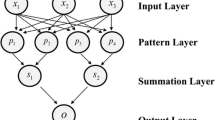Abstract
Artificial Neural Networks (ANN) are pattern recognition and prediction tools modeled on the biologic nervous system. Chemical structures can be decomposed to critical elements that can be used to teach an ANN to relate structure to function. This study was carried out to evaluate a hybrid ANN system for predicting the in vitro anti-HIV1 activity of potential anti-viral drugs based on their chemical structures.
Structure and activity data were obtained from an AIDS anti-viral screen database for 371 drugs. A proprietary algorithm was used to decompose molecules into critical elements that were used as input variables for a probabilistic artificial neural network (PNN). Initial modeling and input variable selection was carried out using Classification and Regression Tree analysis (CART™, 1999).
Important variables together with the terminal node outputs from CART™ were used to train the hybrid ANN to predict in vitro anti-HIV1 activity of each drug. Cross-validated testing results for the ANN model using only the important variables as inputs were compared with hybrid ANN predictions. The final hybrid ANN model correctly classified 96.8% (96.1-99.2%) of the chemical structures re anti-HIV1 activity. The area under the receiver operator curve (ROC) for the hybrid model was 0.97 (0.95-0.99), for the conventional ANN 0.89. The hybrid ANN model performed better for sensitivity, specificity, positive/negative predictive values (p<0.01). We conclude that elements of chemical structure can be used to train a hybrid ANN to accurately predict in vitro activity of drugs against wild type HIV1.
Access this chapter
Tax calculation will be finalised at checkout
Purchases are for personal use only
Preview
Unable to display preview. Download preview PDF.
Similar content being viewed by others
References
Baxt WG, Skora J. Prospective validation of artificial neural network trained to identify acute myocardial infarction. Lancet 1996; 347:12–15.
Patil S, Henry JW, Rubenfire M, et al. Neural network in the clinical diagnosis of acute pulmonary embolism. Chest 1993; 104:1685–1689.
Kirby SD, Danter W, George CFP, et.al. Neural network prediction of obstructive sleep apnea from clinical criteria. Chest 1999; 116:409–415.
Danter WR, Wood T, Morrison NJ, et al. Artificial neural network prediction of survival or death following admission to ICU. Clin Invest Med 1996; 19:S14.
Pilon S, Tandberg D. Neural network and linear regression models in residency selection. Am J Emerg Med 1997; 15:361–364.
Kennedy RL, Harrison RF, Burton AM, et. al. An artificial neural network system for diagnosis of acute myocardial infarction (AMI) in the accident and emergency department: evaluation and comparison with serum myoglobin measurements. Comput Methods Programs Biomed 1997; 52:93–103.
Baxt WG. Application of artificial neural networks to clinical medicine. Lancet 1995; 346:1135–1138.
Guerriere RJ, Detsky AS. Neural networks: what are they? Ann Intern Med 1991; 115:906–907.
Kasabov KK. Foundations of neural networks, fuzzy systems and knowledge engineering. MIT Press, Cambridge MA 1998; 421–474.
Fraleigh S. Fuzzy logic and neural networks. PC AI 1994; 8:16–21.
O’Rourke BM. Analyzing financial neural networks performance: applying fuzzy clustering and tree classification. PC AI 1999; 13:37–40.
Murray D. Tuning neural networks with genetic algorithms. AI Expert 1994; 9:27–31.
Reed RD, Marks RJ. Neural smithing: supervised learning in feedforward artificial neural networks. MIT Press, Cambridge MA 1999; 185–195.
Steinberg D, Cardell NS. Achieving results with next generation data mining techniques. Salford Systems 1998.
Dwinnell W. Modeling methodology 2: model input selection. PC AI 1998; 12:23–26
Weislow OS, Kiser R, Fine DL, et.al. New soluble formazan assay for HIV-1 cytopathic effects: application to high flux screening of synthetic and natural products for AIDS antiviral activity. J Nat Cancer Inst. 1989; 81:577–586.
MacKay DJC. Bayesian non-linear modeling for the energy prediction competition. ASHRAE Transactions 1995; v100 pt.2:1053–1062.
Sarle WS. Stopping training and other remedies for overfitting. Proc. 27th Symposium, Interface of Computing Science and Statistics. 1995; 352–360.
Author information
Authors and Affiliations
Editor information
Editors and Affiliations
Rights and permissions
Copyright information
© 2000 Springer-Verlag London
About this paper
Cite this paper
Danter, W.R., Gregson, D., Ferguson, K.A., Danter, M.R., Bend, J. (2000). A Hybrid Classification Tree and Artificial Neural Network Model for Predicting the In vitro Response of the Human Immunodeficiency Virus (HIV1) to Anti-Viral Drug Therapy. In: Malmgren, H., Borga, M., Niklasson, L. (eds) Artificial Neural Networks in Medicine and Biology. Perspectives in Neural Computing. Springer, London. https://doi.org/10.1007/978-1-4471-0513-8_35
Download citation
DOI: https://doi.org/10.1007/978-1-4471-0513-8_35
Publisher Name: Springer, London
Print ISBN: 978-1-85233-289-1
Online ISBN: 978-1-4471-0513-8
eBook Packages: Springer Book Archive




